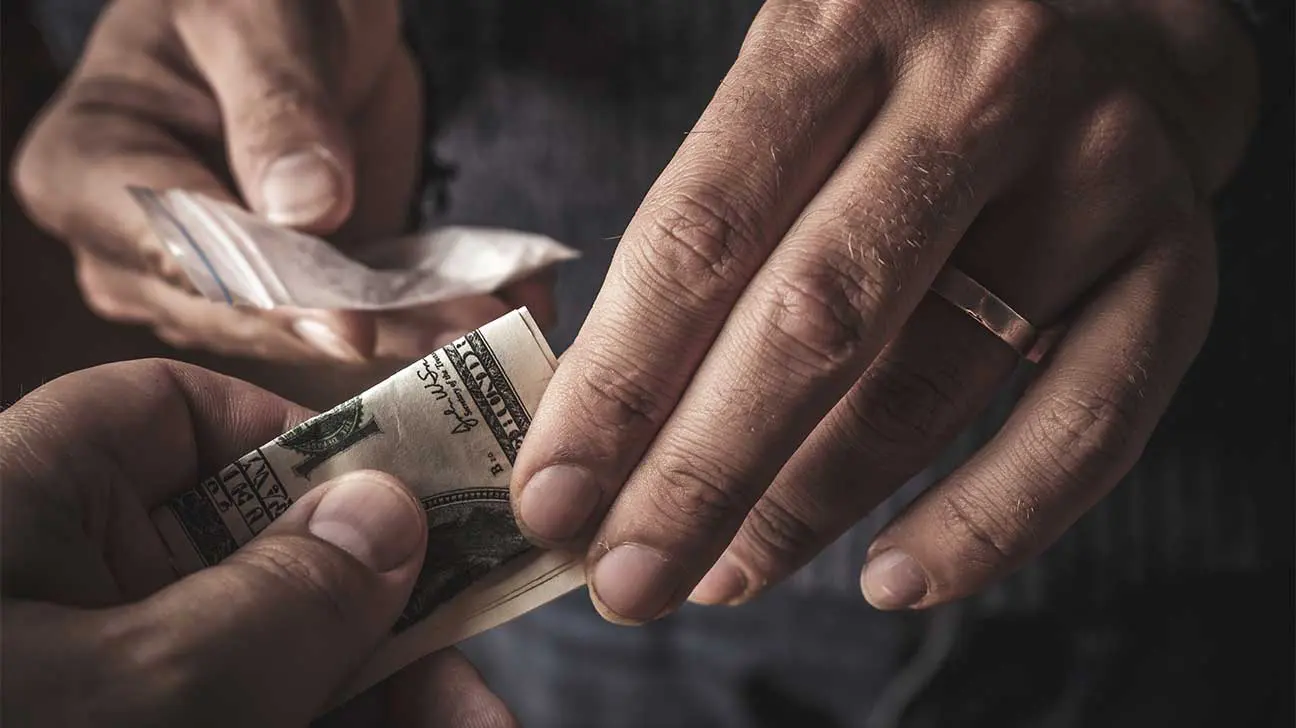
Research shows that people in the United States collectively spend billions of dollars on the purchase of illicit drugs such as heroin, cocaine, methamphetamine, and marijuana each year.
Not all of these drugs are priced the same way. The average cost of illicit drugs can be influenced by a variety of factors, including availability, the type of drug, and where you live.
Common Illicit Street Drugs
The street value of illicit drugs can vary according to the type of drug that is being purchased, as well as the formulation.
For example, a powder, pill, or solid substance such as crystal meth or black tar heroin.
Heroin
Heroin comes in the form of either a white powder, brown powder, or blackish-brown substance known as black tar heroin—all three of which can vary in price according to drug purity level.
The street price of heroin can range between $150 to $500 per gram, according to the United Nations Office on Drugs and Crime (UNODC).
Black tar heroin use is generally cheaper than powder forms because it’s easier to produce and is less pure than powdered forms of the opioid.
Cocaine
Cocaine, or “coke,” is an illicit stimulant drug that is typically ingested in a powder form. One gram can make up about 25 “hits” or 10 lines of cocaine.
The cost of cocaine is between $60 to $110 per gram in the United States, based on the average price data.
Crack cocaine—the rock-like form of coke—is usually cheaper than powder forms, with an average cost of $60 per gram.
Methamphetamine
Methamphetamine, or meth, is an illegal drug that can come in the form of a powder or rock form—also known as crystal meth.
The cost of meth can range from $5 a hit, or $20 to $40 for one gram.
The average dose of meth is 0.2 grams. One gram accounts for about five doses. Wholesale prices (in the kilograms) may be lower.
Molly (MDMA)
Molly is a slang term for the hallucinogenic drug MDMA, also known as ecstasy.
According to the UNODC, the price of MDMA (Molly) can range from $1 to $80 per pill or tablet. The average cost is $5 to $25 per pill.
DMT
Dimethyltryptamine, or DMT, is a hallucinogenic drug that comes in the form of a powder.
The average street price of DMT is anywhere from $100 to $300 per gram. The average dose of DMT is 10 to 60 milligrams (mg).
LSD
Lysergic acid diethylamide (LSD), also known as “acid”, is a synthetic hallucinogen. The cost of LSD (Acid) on the street is about $2 to $5 per hit, according to the U.S. Drug Enforcement Administration.
Ketamine (Special K)
Ketamine is a dissociative anesthetic that is used recreationally. It is also administered as a prescription drug for pain relief and depression.
The street price of ketamine, or “Special K”, can range from $20 to $25 per dosage unit. Legal ketamine infusions for depression treatment can cost upwards of $400 to $2,000 a session.
PCP
Phencyclidine (PCP) is a “party drug” hallucinogen that is most commonly sold in liquid or powder form.
The cost of PCP (angel dust) on the street can range from $20 to $30 for a gram of powder PCP, $5 to $15 per tablet, or $200 to $300 for an ounce of liquid PCP.
Psilocybin Mushrooms
Mushrooms, also known as “shrooms” or “magic mushrooms,” can range in cost from $25 to $30 for a single “trip”. The street cost of psilocybin can range between $50 to $200 an ounce.
Marijuana
Although legal for limited medical use in many states, marijuana—also known as weed, pot, and cannabis—is illegal for recreational use in most states. Marijuana is typically bought in the form of a joint, edible, or by the ounce.
The average cost of weed on the street is $10 to $15 per gram and $100 to $200 per ounce. One joint contains about half of a gram of weed.
Purchasing Sizes For Illicit Street Drugs
There are a wide range of terms that are used to describe common unit sizes for illicit street drugs. This includes actual measurement terms, as well as slang terms.
Purchasing sizes for illicit street drugs may include:
- ounce: sold in one-quarter, one-half-, and one full ounce
- grams: milligram, gram, kilogram
- pound: 16 ounces or 454 grams
- baggie: about 50 mg (small), or 1 gram (sandwich bag)
- elbow: one pound
- 8-ball: eighth of an ounce
- bricks: often equivalent to one kilogram
- bundles: one gram
- teener: 1/16 ounce
- single dose: such as one pill, line, or hit
- bottle: for pills or tablets
Common purchasing sizes vary depending on the type of drug. Heroin, for instance, is commonly sold in bags. Ecstasy, on the other hand, might be bought by the dose or by the bottle.
Prescription opioids such as methadone or prescription benzodiazepines may be illicitly sold in their original pill or liquid form, or in a crushed up powder form.
What Factors Can Affect Street Prices For Illicit Drugs?
Average street prices for drugs aren’t fixed. They are subject to change according to a whole host of factors.
Factors that can affect street prices for illicit drugs include:
- drug supply
- affordability
- demand
- local drug policy
- prevalence of the drug
- competition between dealers in the local drug market
- ease of drug trafficking and distribution
- travel restrictions
- geographic location (Canada, Europe, USA, South America)
- drug purity level (e.g. whether it’s been cut with other substances such as the synthetic opioid fentanyl)
- drug laws
- law enforcement presence
The cost of many illicit drugs has shifted over time, due to a variety of economic, social, cultural, and political factors.
The extent to which these factors influence prices can vary based on location as well as general attitudes towards illicit drugs, as demonstrated by the public, law enforcement, and policymakers.
Illicit Drug Abuse And Addiction
Buying illicit drugs like heroin or cocaine can be a sign of drug abuse. That is, a compulsive pattern of misusing drugs for their effects or for other personal reasons.
Over time, the use of illicit drugs can lead to significant life problems, including:
- financial issues due to healthcare and drug costs
- difficulty finding or keeping employment
- relationship problems
- physical and mental health issues
- legal problems
People who buy drugs off the street regularly may pay more and more for these drugs over time, as they develop a higher tolerance and need more of the drug to get through the day.
If this describes you or a loved one, finding an addiction treatment program may be your best option. Recovering from drug abuse and addiction is possible.
Find Help For Drug Abuse And Addiction
The first step towards getting help for addiction is to find substance abuse treatment for yourself or a loved one. Reach out to AddictionResource.net today for more information.
Addiction Resource aims to provide only the most current, accurate information in regards to addiction and addiction treatment, which means we only reference the most credible sources available.
These include peer-reviewed journals, government entities and academic institutions, and leaders in addiction healthcare and advocacy. Learn more about how we safeguard our content by viewing our editorial policy.
- ABC 11 Eyewitness News—‘We treat it just like a meth lab:’ Vice unit talks busting large Wake Forest drug operation
https://abc11.com/dmt-drug-wake-county-bust-dust/5674888/ - Connecticut Department of Consumer Protection (DCP)—Drug Control Division
https://portal.ct.gov/DCP/Drug-Control-Division/Drug-Control/ - McLaren Healthcare—Regional Street Drug Trends PDF Presentation
https://www.mclaren.org/Uploads/Public/Documents/BayRegion/documents/presentations/B_Gatza_Presentation_compressed.pdf - Sacramento County Department of Homeland Security (DHS)—Methamphetamine Trends in the Probation Department
https://dhs.saccounty.net/BHS/Documents/SUPT/Methamphetamine/Coalition-2020/MA-ADS-2020-02-13-Methamphetamine-Trends-in-the-Sacramento-County-Probation-Department.pdf - RAND Corporation—What America’s Users Spend on Illegal Drugs, 2006-2016
https://www.rand.org/pubs/research_reports/RR3140.html - Save on Cannabis—How Much Does Weed Cost? Cannabis Price Guide 2021
https://saveoncannabis.com/weed-price-guide/ - Seattle Times—Meth makes a comeback and it’s purer, cheaper and much more lethal
https://www.seattletimes.com/nation-world/meth-makes-a-comeback-and-its-purer-cheaper-and-much-more-lethal/ - The Journal of Pain—Street prices of prescription opioids diverted to the illicit market: data from a national surveillance program
https://www.jpain.org/article/S1526-5900(13)00492-6/fulltext


